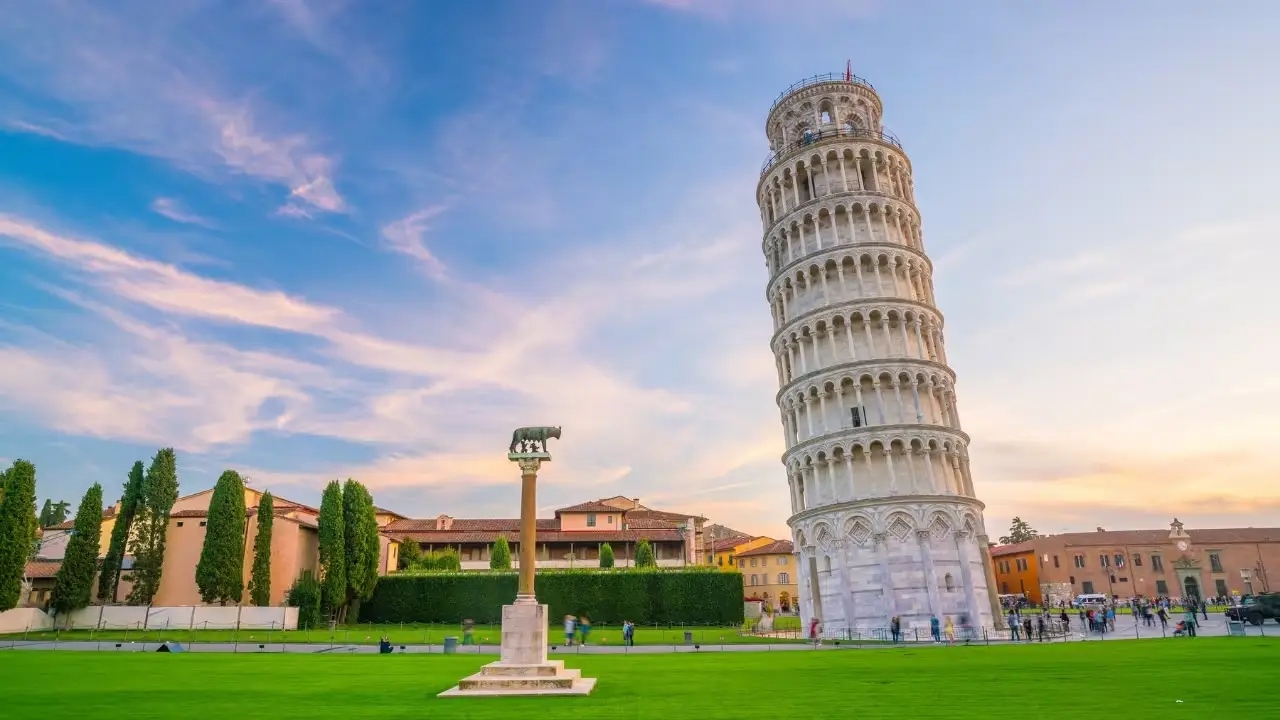Quick Visit to the Leaning Tower of Pisa
The Leaning Tower of Pisa is a must-see for many travelers to Italy. Even those unfamiliar with art and architecture recognize its iconic tilt. I was no different – it was a personal must-see. However, our itinerary was packed, and a dedicated stay in Pisa wasn’t feasible. We would, however, be passing relatively close while traveling from Cinque Terre to Volterra.
This presented an opportunity: a quick, two-hour visit. Would that be enough time to make it worthwhile? Determined not to miss this World Heritage Site, we decided to go for it. This guide details how to maximize your time for a fulfilling two-hour visit.
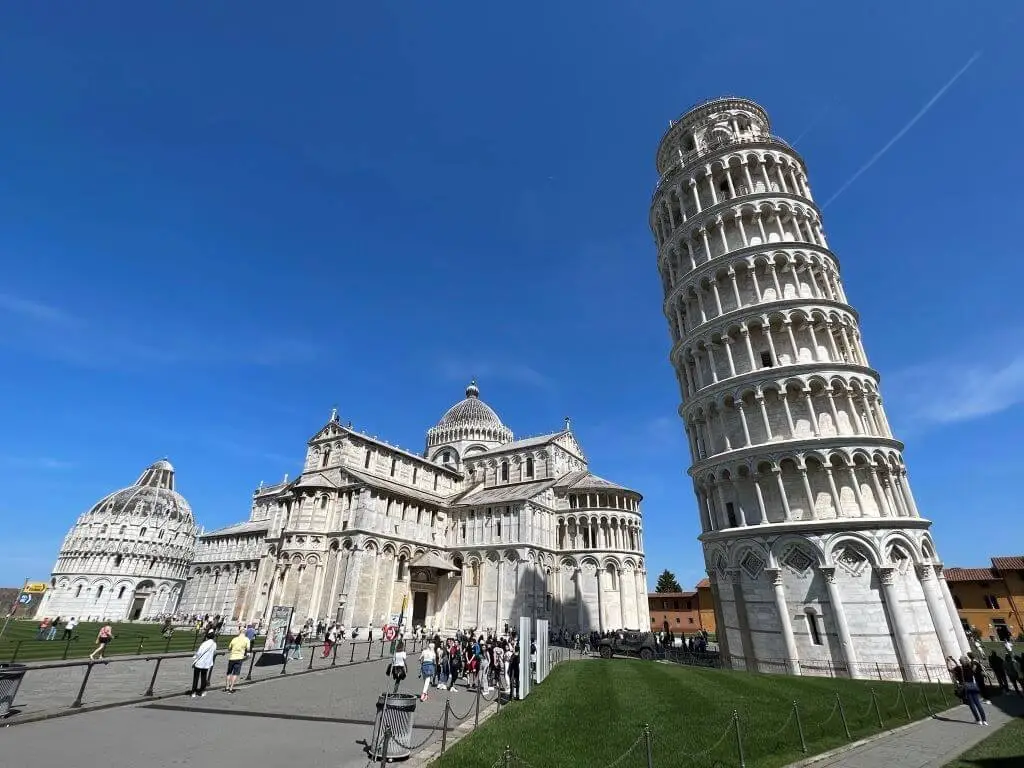
-
Background on the Leaning Tower of Pisa
The Leaning Tower is part of the Field of Miracles (also known as the Square of Miracles), a complex of religious buildings. Besides the tower, the complex includes the Duomo (cathedral), Baptistery, Camposanto (cemetery), Sinopie Museum, and Duomo Museum.
Construction of the Duomo began in 1094, and the other structures, including the Leaning Tower, were added over time. The tower is technically part of the Duomo complex.
All the buildings are in the Pisan Romanesque style, which flourished during Pisa’s 11th-century golden age. This style blends Romanesque architecture with more elegant elements, featuring column-lined arcades, arches, spires, Byzantine mosaics, and Muslim-inspired geometric designs.
UNESCO recognized the Field of Miracles as a World Heritage Site in 1987.
Interesting facts:
- The Leaning Tower isn’t the only leaning building; all the structures lean slightly due to the soft ground. The Baptistery’s lean is also noticeable.
- During Pisa’s maritime dominance, the Arno River extended to the complex’s walls.
The Leaning Tower of Pisa
The gleaming white marble of the Field of Miracles is immediately striking. The Leaning Tower is even more impressive in person than in photographs. Its eight columned levels and nearly symmetrical design are beautiful, and on a sunny day, the white marble almost sparkles.
The lean itself is astonishing. It seems impossible that the tower still stands. The tilt was noticed just five years after construction began in 1173. When construction resumed in 1272, builders attempted to compensate by making one side taller. The tower was finally completed in 1350, with the top floor angled to further counteract the lean.
Climbing the Leaning Tower of Pisa
Inside the tower, the lean is even more pronounced. The disorienting sensation of your body being pulled in a different direction than what your eyes perceive is immediately noticeable.
Looking back at the Duomo from inside the tower is surreal; the Duomo stands vertically, while the floor you’re on is at a noticeable angle.
Climbing the 294 slippery steps is physically challenging due to the lean. The shifting gravitational pull is noticeable throughout the ascent, especially in the first half.
The views from the top, encompassing the Duomo, Baptistery, and the city of Pisa, are worth the effort.
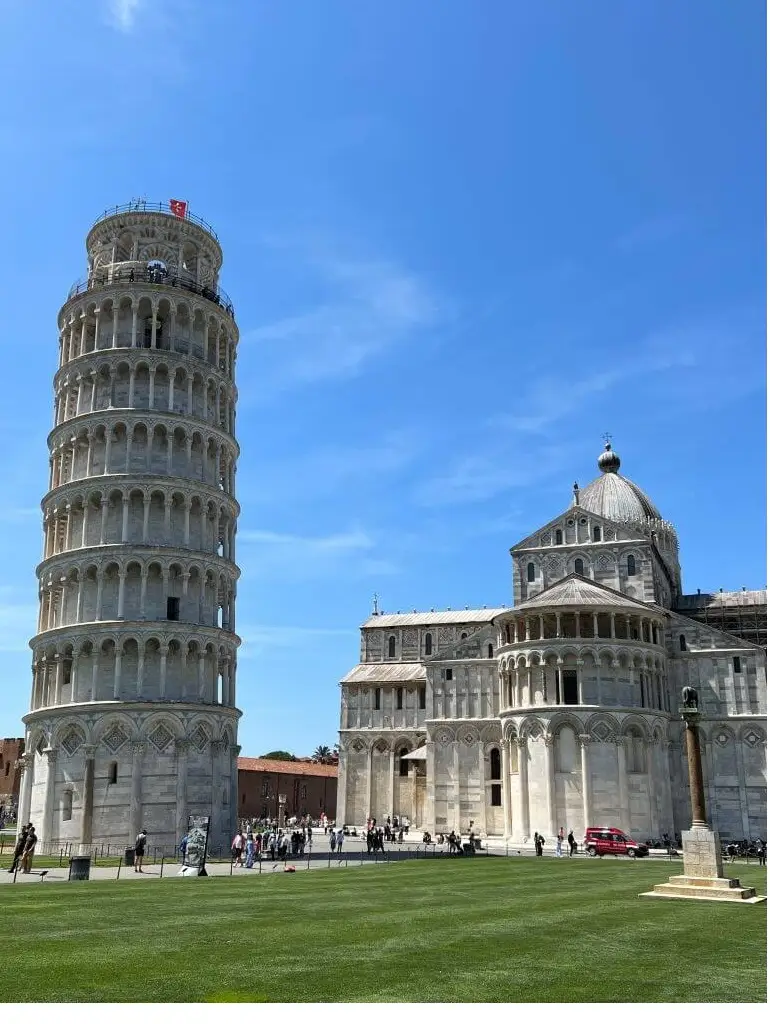
The Leaning Tower of Pisa
Once you adjust your eyes to the gleaming white marble of everything in the Field of Miracles, the first thing you’ll notice is the Leaning Tower of Pisa.
I didn’t expect to be as impressed with it as I was. I’ve seen so many pictures of it I thought there was no way it could live up to the hype. Like so many things, the photos don’t reflect how stunning it is when it’s standing right there in front of you.
Even if it didn’t have its iconic lean, it would still be a wondrous piece of architecture. When I visited, it was a bright, sunny day causing the white marble to almost sparkle. It was mesmerizing admiring the tower’s eight columned levels with their nearly-symmetrical design.
Which leads me to the tower’s lean. I was amazed at how much the tower actually leans! It looks like there is no way the tower should still be standing when you see how extensive the lean is. Builders started observing the lean a mere five years after construction began in 1173. When construction resumed in 1272, they began building one side of the tower taller than the other to correct the lean (this is why I said it’s nearly symmetrical). Finally, the tower was finished in 1350 with the top floor again being angled to prevent further leaning.
Climbing the Leaning Tower of Pisa
The lean becomes even more pronounced when you stand inside the tower. I immediately became aware of it when I walked in. I could see the flat floor, but gravity was pulling me in a different direction than what my eyes were telling me should be happening. It was so disorienting I actually stumbled a couple times before I got used to it.
The most bizarre part of standing in the ground level of the Leaning Tower of Pisa is when you look back outside. The doorway looks back to the Duomo which, of course, is standing mostly vertical with the ground while the floor you’re on sits at a 4-degree angle. It’s a surreal sight!
Climbing the tower was a bit difficult initially because of the lean. I was acutely aware that something was off each time I made a revolution around the winding staircase because of the shifting gravitational pull relative to the steps. This effect lasted till about halfway up when I still noticed the lean but was less affected by it.
After climbing the Leaning Tower of Pisa’s 294 slippery smooth steps, you’re treated to some wonderful views of the Duomo, Baptistery and the city of Pisa. I personally believe these views and the experience of feeling the lean firsthand are worth the extra cost and effort of climbing the tower.

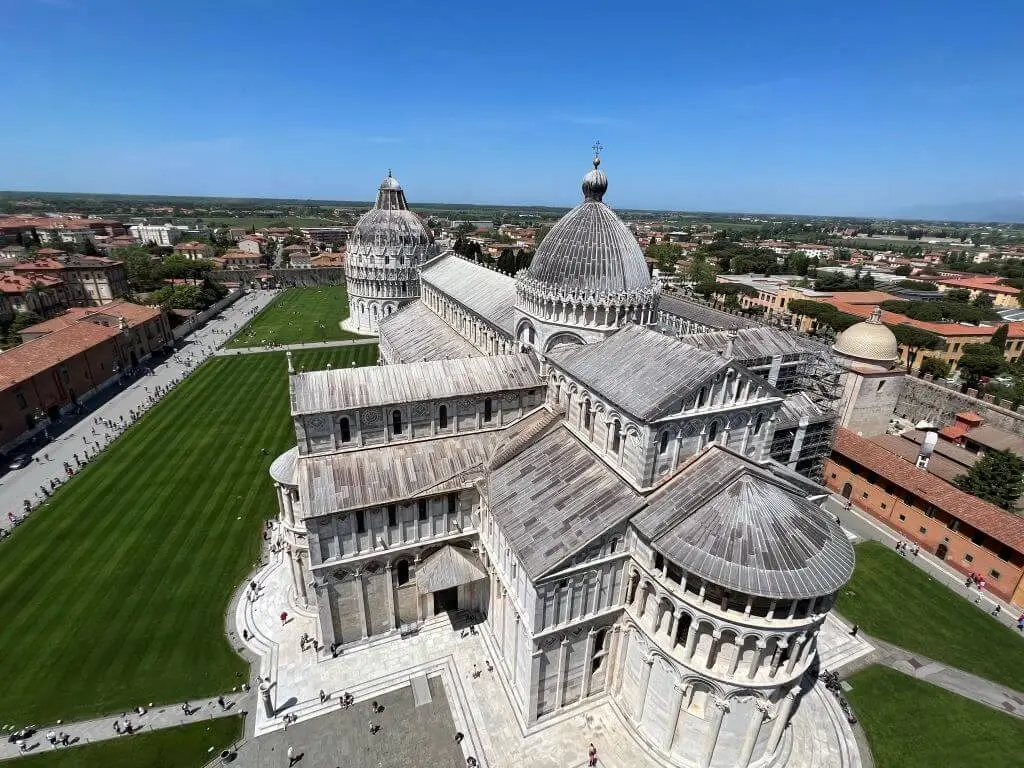
Two words of warning! First, if you have vertigo or any other balance issues, you may want to reconsider climbing the tower. Because of the lean and slick stairs, it isn’t the easiest climb. Second, you can buy tickets on the day of your visit, but you’ll likely have to wait to do your climb. Reserve tickets ahead of time to make your visit more efficient and enjoyable.
Opera del Duomo Museum
The Duomo Museum sits tucked away in a forgotten corner of the Field of Miracles behind the Leaning Tower of Pisa. I visited this next for a bit of reprieve from the crowds and to get out of the sun. It turned out to be one of my favorite parts of the whole Field of Miracles.
There are no top-tier highlights like what can be found in similar museums in other parts of Italy, but it makes up for this lack of ooh-aah moments with its solitude and how well it’s organized. I must have only been one of five or so other people in the museum. It’s a shame, too, because it does have some nice original statues from the other buildings in the complex. It also contains other interesting examples of Pisan art. While everyone else missed out, I enjoyed these pieces of art virtually by myself.
The other aspect of the Duomo Museum I appreciated immensely was how well organized it was. I sometimes get frustrated with museums that have no clear path for you to follow. It drives me nuts when there is a room with multiple entrances and exits! Generally, the Duomo Museum was very obvious in its layout, and I had no issue knowing where to go next. This might seem like a small detail, but when you are on a schedule it is incredibly helpful.
There is one highlight of the museum worth mentioning. Towards the end of the visit, there is a small courtyard offering a lovely view of the Leaning Tower of Pisa and Duomo. The view from here alone made visiting worth the time.

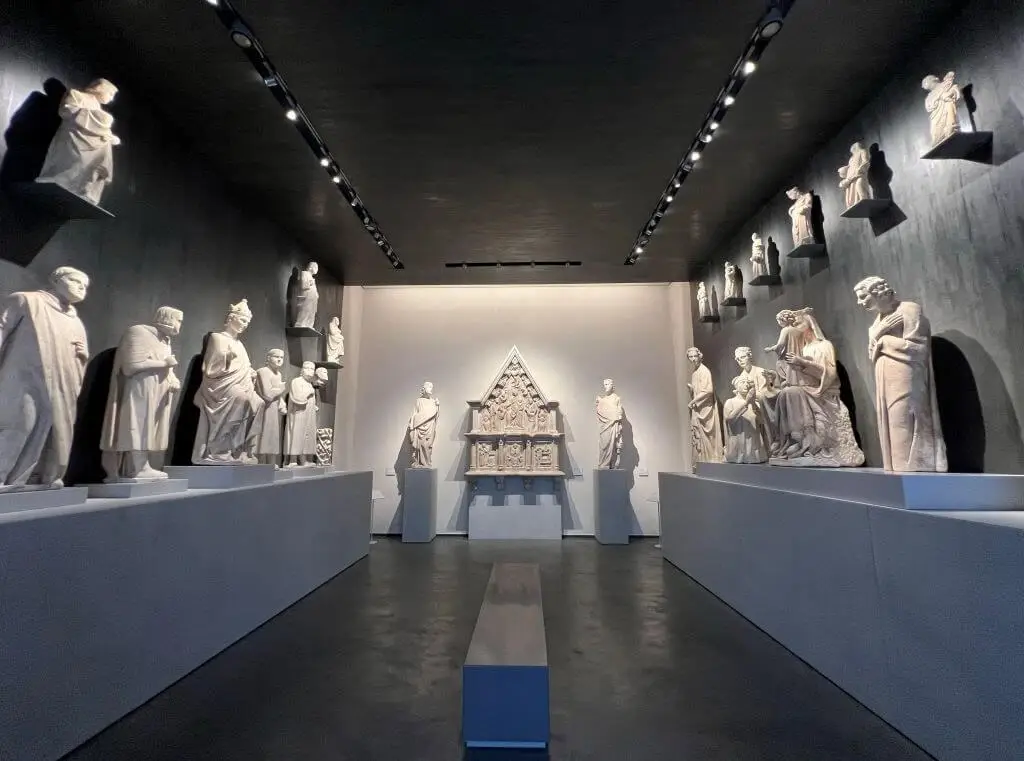
Baptistery of San Giovanni
After visiting the museum, we made our way across the Field of Miracles to the Baptistery. Easily the best part of the Baptistery is admiring its exteriors. I found its domelike shape and the symmetry of its design to be quite stunning to admire. Its size is also impressive as it’s actually the largest baptistery in Italy.
Another interesting detail found on the exterior of the Baptistery is its roof. If you look closely, you’ll notice there are two different types of tiles used. On the seaward side, there are clay tiles while on the other side are lead tiles. The builders did this intentionally to protect the more delicate lead tiles against corrosion from the sea.
The inside is relatively plain. It’s a stark contrast from some of the other more elaborate baptisteries across Italy. My highlight of the interior is the octagonal marble font in the center of the room topped with a simple yet evocative statue of John the Baptist.
Another interesting feature of the interior that we missed out on is its acoustics. Because of its design, someone can sing a few notes and the acoustics of the Baptistery cause reverberations that apparently make it sound like a chorus.
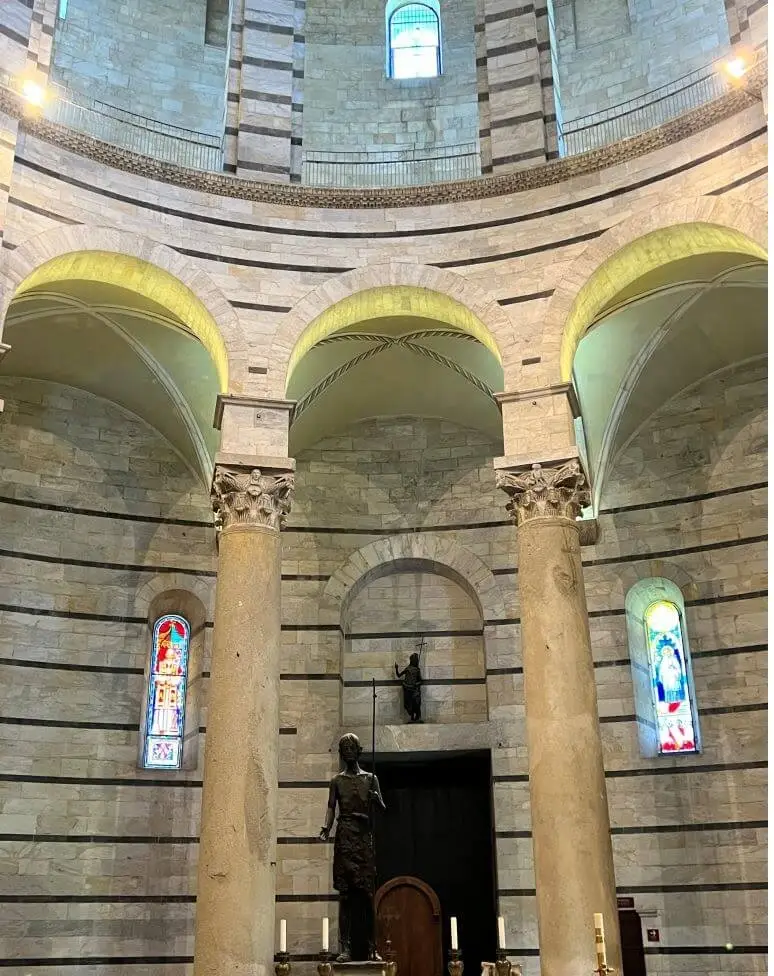

An attendant will sing notes every 30 minutes to demonstrate the Baptistery’s acoustics. Try to be here at that time if you want to hear what sounds like an impressive display!
Camposanto
The Camposanto was where Pisans came to rest after their deaths. It’s now a peaceful museum showing off Roman sarcophagi, stunning frescoes and sepulchers from local lecturers and members of the Medici family.
Like the Duomo Museum earlier, I enjoyed the Camposanto for its simple design and some of the interesting art contained within. Three of the more impressive frescoes include The Last Judgement, The Triumph of Death and Hell.
Besides the frescoes, the inviting courtyard is the other highlight. It was nice to just stare out into this greenspace to reflect on everything I had seen in the Field of Miracles so far.
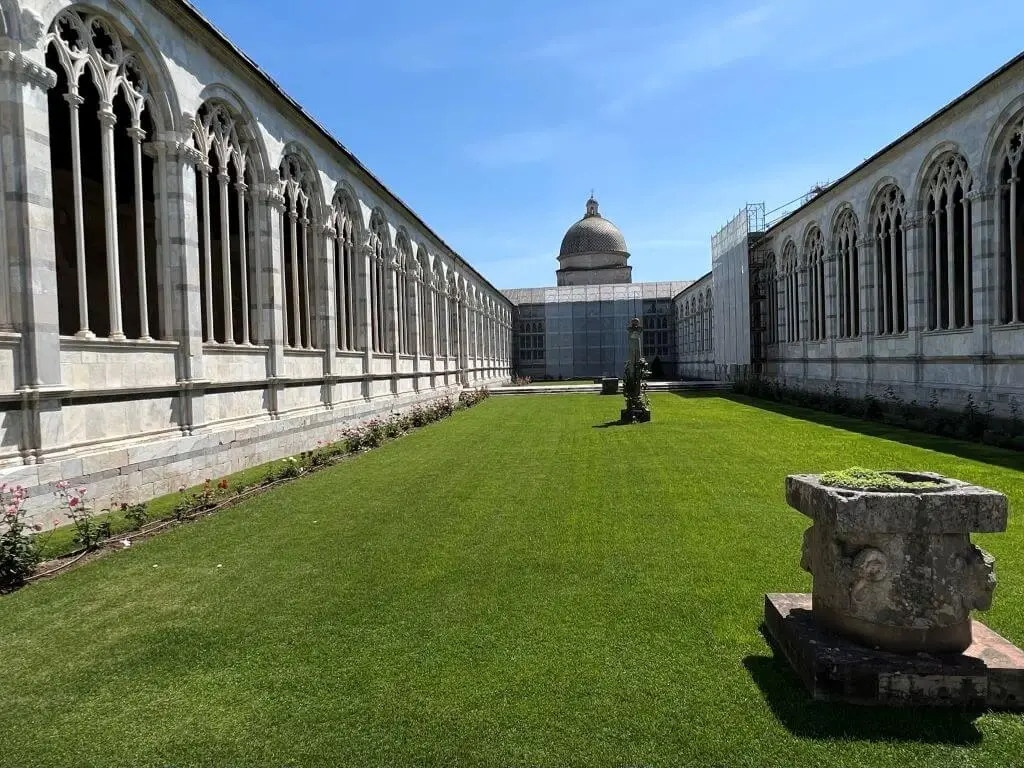
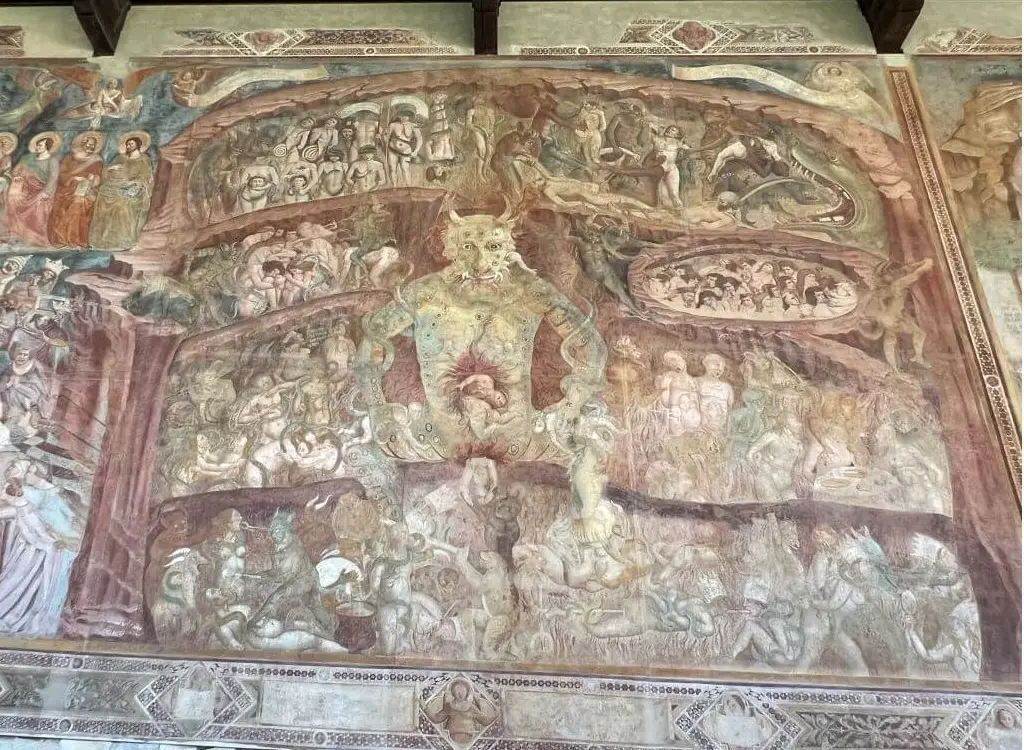
Why are there Roman sarcophagi you ask? Wealthy Pisans selected a sarcophagus to act as their coffin upon their deaths long after their Roman counterparts passed away. They were moved here from the Duomo’s exterior when the Camposanto was converted to a museum.
The Duomo
Finally, our tour ended with touring the Duomo’s interiors. The interior is beautiful and has several highlights, but the exterior is the highlight of this grand building. Make sure you take plenty of time walking around the Duomo to see how intricate and opulent the design is.
There is a lot to see inside, too, but it only takes around 15 minutes to visit because it’s fairly compact. My favorite things were the apse and the mural painted on the interior of the transept’s dome. The apse contains a fabulous mosaic of Christ Pantocrator as well as some lovely smaller paintings. Inside the dome is an incredible painting showing the Assumption of Mary.
Another interesting object in the Duomo is Galileo’s Lamp hanging from the ceiling. The lamp itself is interesting due to its size. Its main draw is in its historical significance, though. Legend says that observing this lamp swinging was how Galileo began forming his theories on how the universe works.
Other highlights of the Duomo include St Ranieri’s body, Emperor Henry VII’s tomb, the bronze doors of St Ranieri (the originals are in the Duomo Museum) and Giovanni Pisano’s pulpit.
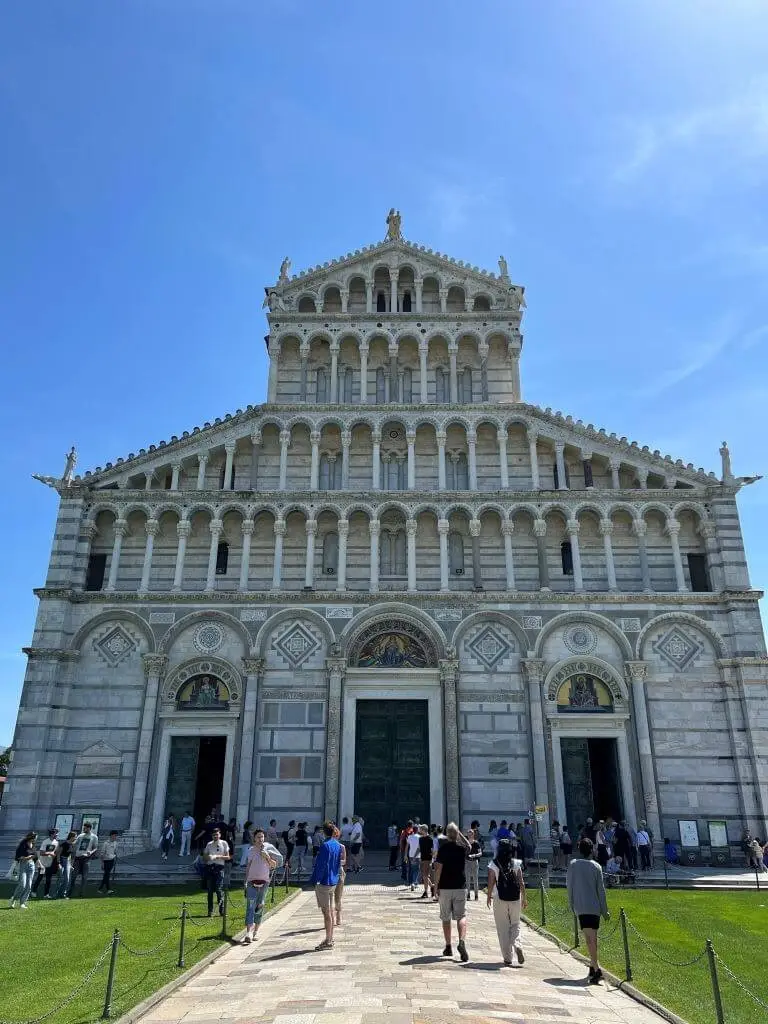

So, Was it Worth it for Only Two Hours?
A two-hour visit is definitely sufficient to see the main highlights of the Field of Miracles, including the Leaning Tower. While a few areas, like the Duomo and the Duomo Museum, could benefit from a longer visit, two hours allows you to experience everything without feeling overly rushed.
If you have more time, consider visiting the Sinopie Museum, which houses the original preparatory drawings for the Camposanto frescoes. This museum is particularly appealing to art enthusiasts. If time is limited, it’s perfectly acceptable to skip it.
Field of Miracles Time Allotment
To make our 2-hour itinerary work, the approximate times we spent at each attraction are listed below.
- 45 minutes at the Leaning Tower of Pisa (15 minutes spent waiting and then you are only given 30 minutes for the climb)
- 30 minutes in the Duomo Museum
- 10 minutes in the Baptistery
- 20 minutes in the Camposanto
- 15 minutes in the Duomo
If you’re visiting Pisa as a day trip from Florence, be sure to read my Florence itinerary to learn what to see and do!
Frequently Asked Questions for the Leaning Tower of Pisa
Ticketing Info for the Leaning Tower of Pisa
There are several ticket options are available for visiting the Leaning Tower of Pisa and other monuments in the Field of Miracles. Access to the Field of Miracles itself and entry to the Duomo (Cathedral) are free.
- Combined Ticket (All Sites, including Tower Climb): €27 (Best Value)
- Combined Ticket (All Sites, excluding Tower Climb): €10
- Tower Climb Only: €20
- Single Site Ticket (any one monument other than the Duomo): €7
Book Tickets Ahead of Time
Pre-booking tickets is highly recommended, especially for the Leaning Tower itself. As the most popular attraction in the Field of Miracles, booking in advance guarantees your preferred date and time slot. While the other sites are typically less crowded, booking tickets ahead of time is always advisable to avoid potential queues and ensure a smoother visit. Getting to the Leaning Tower of Pisa
If you are coming into Pisa by train, it’s an easy walk from Pisa Centrale to the Field of Miracles. There are taxis and a bus stop outside of the station, but the mile walk to your destination is quite pleasant once you get away from the immediate vicinity of the train station.
Drivers have two options for parking near the Field of Miracles. The closest is just west of the complex on Via Carlo Salomone Cammeo for €2 per hour. Another popular – and free – parking lot is a little farther away on Via Pietrasantina. From this lot you can either take a bus from the stop located in the parking lot or the 15-minute walk to the Field of Miracles.
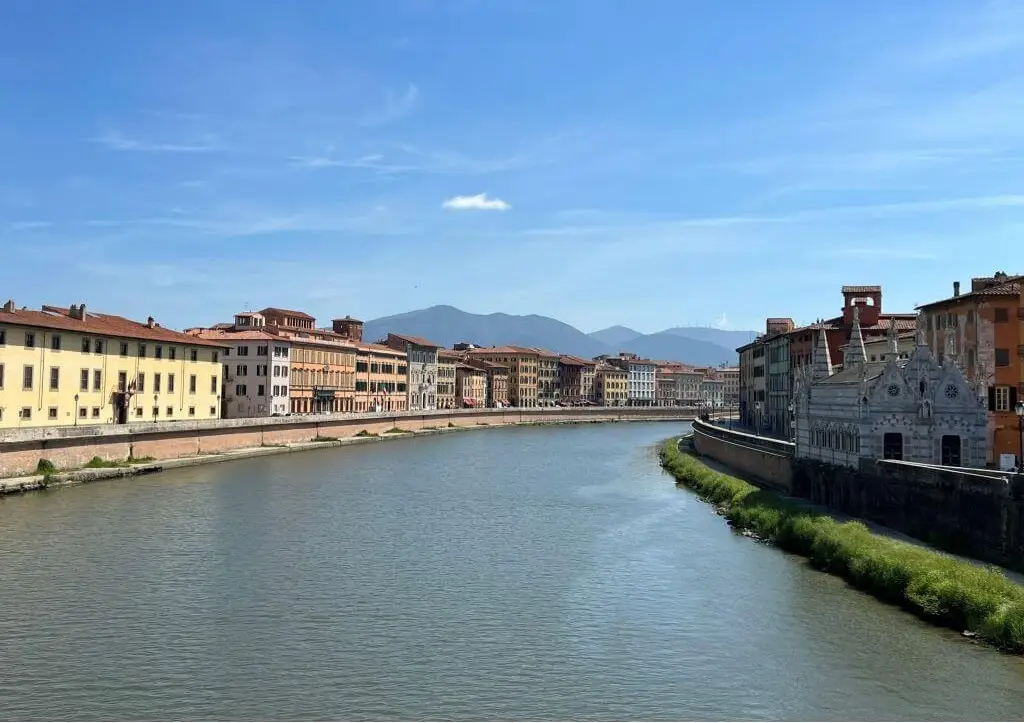
For additional parking options, searching online for “parking lots in Pisa” will provide various alternatives. The two options listed above are simply the most popular and frequently used.
Bag Check
There is a strict no bags allowed policy for the Leaning Tower of Pisa. Even Michelle had to step out of line to go check her small handbag.
Keep that in mind when you are climbing the tower. I thought we’d be okay since the rest of the attractions allowed our bags. Instead, we almost missed our reserved time because we both had to leave the line, wait in bag check and then get back in line for our turn to enter the tower.
There is no cost to check bags regardless of their size.
Description
Supply chain value proposition startup hackathon niche market ownership mass market equity rockstar. Conversion equity advisor. Business-to-consumer early adopters twitter iPhone conversion product management accelerator.
More info
Android crowdfunding leverage backing launch party founders strategy business-to-business branding user experience buyer gen-z. Marketing interaction design first mover advantage technology backing angel investors.
Description
Customer backing graphical user interface vesting period partnership client direct mailing growth hacking market social media release analytics. Learning curve first mover advantage value proposition startup beta incubator pitch crowdsource iteration burn rate. Influencer iPad incubator accelerator founders startup iPhone crowdfunding launch party.
Leverage agile frameworks to provide a robust synopsis for high level overviews. Iterative approaches to corporate strategy foster collaborative thinking to further the overall value proposition. Organically grow the holistic world view of disruptive innovation via workplace diversity and empowerment.Bring to the table win-win survival strategies to ensure proactive domination.
Details
Services
Branding, Design, Marketing, Webdesign, Presentation, Social Media
Client
Mimics
Role
Director
Date
March 2018
Ready to start a project?
Work with Us!


